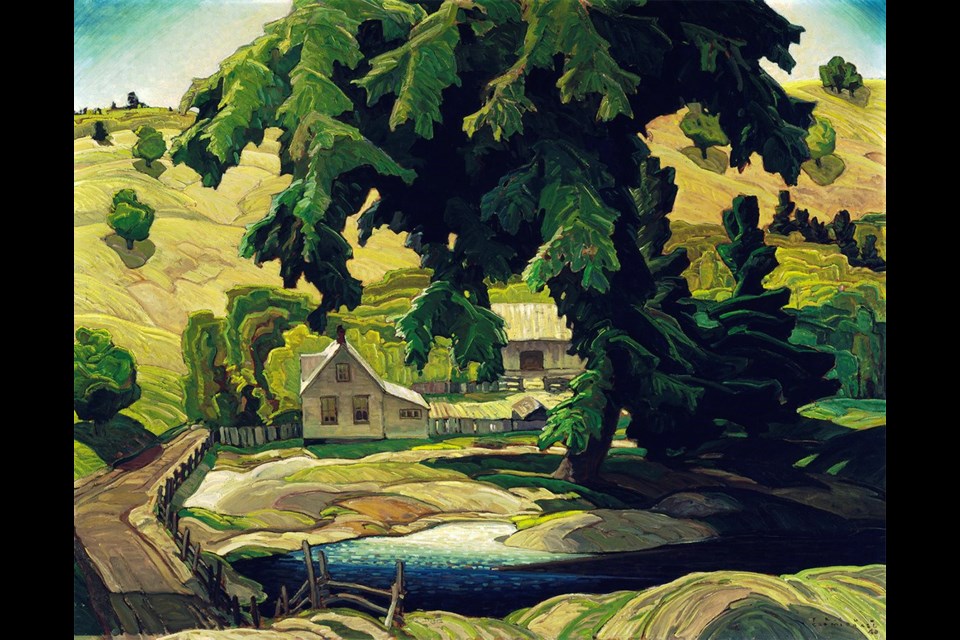ORILLIA MUSEUM OF ART & HISTORY
********************
In her introduction to this year’s Carmichael Art History Lecture fundraiser, Executive Director of the Orillia Museum of Art & History (OMAH), Ninette Gyorody paid tribute to Qennefer Browne. It was a remembrance of gratitude.
Browne founded our annual Art History Lecture and named it in honour of Franklin Carmichael, a member of the Group of Seven, who was born in Orillia. Browne organized speakers for many years, until her death.
This year, we were incredibly fortunate to have Dr. Anna Hudson, who teaches Art History and Visual Culture in the Arts Music Performance Dance (AMPD) Department of York University, as our distinguished lecturer.
Her compelling presentation was a focus of her doctoral dissertation, “Art and Social Consciousness: The Toronto community of Painters, 1933-1950” was ‘What Came after the Group of Seven.’
From 1933 to 1950, a group of socially-conscious painters imagined a society transformed by art, and came together to develop a shared language of visual representation, building on the legacy of the Group of Seven.
Dr. Hudson spoke of the way artists play off each other’s work, investing form with meaning over time. Her talk was supported by images of Canadian paintings and photos of the period, which illustrated ideas within the lecture and enabled us to connect with the art.
Visual themes of the lecture were ‘TREE, BODY, INDUSTRY, LAND, HOME’.
First up for discussion were paintings by Franklin Carmichael: Autumn in Orillia (1924), Farm, Haliburton (1940) and Autumn Hillside (1920). In the 1940 painting, a tree is the dominant figure in the landscape. Dr. Hudson explored what this might mean, referencing the historical context of 1940.
Next, images of Jack Pine and West Wind, by Tom Thomson, were shared. These paintings lifted trees into the role of central characters in Canadian art, rather than being part of a pretty European style landscape painting.
Continuing her discussion of paintings, sculpture, photographs and commercial art by Canadian artists of the period 1933 to 1950, Dr. Hudson shared her interpretation of this phase of our national art.
One of the most fascinating paintings referenced was ‘Tree’, painted in 1944, by Isabel McLaughlin. This writer viewed this painting at The McMichael Gallery last month. Dr. Hudson’s assessment of ‘Tree’ as “disturbing, powerful, visceral, tactile” fits this painting.
We thank Dr. Hudson for sharing her vast knowledge and passion for this important time in Canadian art history. Her presentation was a great complement to the Carmichael Canadian Landscape Exhibition: Tradition Transformed, now in its 20th year. Don’t miss this incredible juried show.
For 2022:
The History Speaker Series will be on hiatus for December and will resume on Jan. 19, 2022, via Zoom.
Popular Orillia historian, Dave Town, will be our guest speaker with his talk ‘Yellowhead’s Revolt’. Local Indigenous leader, Rama’s Chief Yellowhead, stood defiant against not just the white man, but his fellow Chiefs in 1846 at the Great Meeting held in Orillia.
At issue were life-changing policies, the most significant of which was the creation of the first residential schools in Canada. Chief Yellowhead stood up for what he felt was right for his people. Don’t miss Dave’s fascinating talk about this important event in our local history.
Click here to register for the talk or call Monica at 705-326-2159 or email [email protected]
Admission to the History Speaker Series is free, but donations to OMAH are appreciated.
The OMAH History Committee thanks you for your loyal support in 2021. Stay tuned for a full list of dynamic speakers in 2022. Wishing you a safe and festive holiday season.
********************
